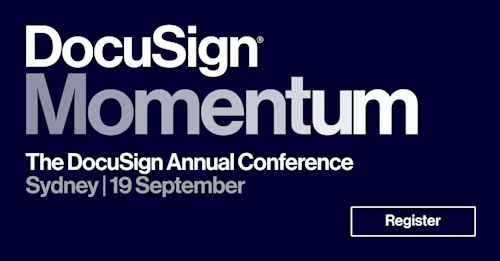Are Identity Fraud Prevention and Customer Experience Competing Priorities?

Do you want to switch to our US site?
Here are the most common questions we get asked by those new to eSignatures. If yours isn’t answered below, then by all means get in touch.

Here are the most common questions we get asked by those new to eSignatures. If yours isn’t answered below, then by all means get in touch.
1. I need to get someone to sign a bunch of documents. Can I send more than one document to one person?
Absolutely. You can send one document or multiple documents as part of a single transaction with Docusign. It doesn’t matter if those documents need to be signed by just that one person or by a number of people, either. Docusign can handle any signing situation.
2. What types of documents can be signed electronically?
Almost any type of contract or agreement can be signed electronically. In Australia, the Electronic Transactions Act 1999 allows you to accept signatures electronically for most documents used in business today. Only a small handful of document types, such as Deeds, still need a wet ink signature.
Here’s a snapshot of the huge variety of documents that can benefit from eSignatures:

3. I want to use Docusign within the business systems that our employees are already familiar with. What are some of the more common integrations?
Docusign partners with some of the world’s leading platforms, offering pre-built integrations with over 400 different partner applications and systems. The most common integrations include those with Salesforce, Microsoft (including Office 365, SharePoint, Outlook and Dynamics), SAP (including Ariba and SuccessFactors) and Google. See all integrations here.
4. Do I need to set up the document every time I send it?
No. If you are sending out the same type of document or using the same process to send out documents on a regular basis, then you can use Docusign Templates to speed up this process. Once the document has been set up as a Template then it is easy to simply resend to whichever parties need to sign it.
5. What happens to all those signed documents that Docusign manages? Where do they go?
Docusign is a cloud-based solution; and uses local Australian data centres to host our service for Australian customers. This ensures that all of your data and documents remain onshore, meeting any data residency requirements. We also have data centres in Europe, USA and Canada should there be a requirement to host data elsewhere.
6. How secure are your authentication methods? In other words, how does Docusign know that the person signing a document is who they say they are?
Docusign identifies the signer of a document in one or more ways. For all agreements, Docusign captures the name, email address, IP address, date and time of each recipient’s activity related to a transaction within an audit trail. You can add more stringent two-factor authentication methods such as SMS authentication, knowledge-based authentication or ID checks (e.g. verifying a drivers’ license or passport).
Once an agreement has been completed, it can be downloaded from Docusign as a PDF with a tamper-evident seal (Digital Certificate). This seal will then indicate if the document has been changed since being downloaded.
Docusign uses industry best-practice encryption standards, ensuring that your data and documents are encrypted while in transit and at rest.
7. We would like our client to sign a document when we meet face-to-face. Is this possible?
Yes. Docusign absolutely supports “in-person” signing – you can bring up the agreement on a tablet or other device at your face-to-face meeting and ask your client to sign on the device.
8. Do all signers need to have an email address?
Yes. All people receiving and signing a Docusign transaction need their own email address, because we use their email address as the primary way to identify them. As per our answer above, we also capture their name, IP address of the device used, and date and time of the transaction as additional evidence.
9. What happens when two signers have the same email address?
That’s OK. After all, sometimes partners share a family email address or co-workers share a business address.
Given that some people may share email addresses, Docusign also captures the name and IP address of the device that a document is signed on. This additional information enables us to identify every single recipient of a transaction.
If you need to send a document to two people who share an email address, you’ll need to set up two different recipients as part of the transaction – use their different names but the same email address for each recipient.
You can then assign actions (where to sign etc.) to each of those recipients. Separate emails will then be addressed and sent to each recipient for signing, even though they are going to the same email address. Learn more about sending Docusign documents to shared email addresses.
Any other questions?
Docusign is here to help with all of your questions about eSignatures. Contact us today or join us at Momentum Sydney on September 19th at Doltone House Darling Island to learn more about the benefits of Docusign eSignature and the Docusign Agreement Cloud.


Related posts




